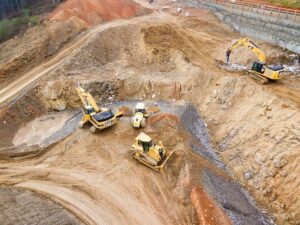Earthwork Frequently Asked Questions: Expert Answers on Excavation, Grading, and Site Preparation
A robust understanding of earthwork underpins every successful construction project, providing the groundwork for structural integrity, drainage management, and site readiness. By defining earthwork as the systematic process of moving, grading, and compacting soil and rock, this article explores core methods, equipment, and safety measures needed to transform raw terrain into stable building platforms. You will discover how precise grading prevents erosion, how targeted excavation supports foundations, and how expert contractors leverage advanced machinery to streamline site preparation. Alongside these technical insights, we introduce Earth Works, LLC’s value-driven approach—serving Kentucky general contractors with tailored solutions, transparent cost planning, and compliance mastery.
Below is a roadmap of the topics we cover:
- Definition, purpose, and benefits of earthwork, plus company quality assurances
- Types of excavation—from foundations to mass earthmoving—and local permitting
- Land grading principles and its impact on drainage and erosion control
- Drainage system options, erosion-control materials, and maintenance best practices
- Comprehensive site preparation steps, risk mitigation, and timeline factors
- Cost drivers for excavation and grading, contractor selection advantages, and technology efficiencies
- How Earth Works, LLC addresses Kentucky’s soil conditions, regulations, and safety standards
What Is Earthwork in Construction and Why Is It Essential?
Earthwork refers to the planned removal, relocation, and compaction of soil and rock to prepare a building site, road, or infrastructure corridor. It establishes a stable base for foundations, ensures proper water flow, and reduces long-term settlement risks. In Kentucky’s varied topography—from clay-rich backyards to silty commercial plots—professional earthwork transforms challenging terrain into predictable, safe platforms for any structure.
Consistent earthwork practices mitigate soil erosion, optimize load-bearing capacity, and prevent costly structural issues down the line. By integrating surveying data with GPS-guided machinery, experienced contractors achieve uniform compaction and slope accuracy. This foundational phase also uncovers hidden obstacles—such as organic detritus or buried utilities—allowing civil engineers to adjust designs early and avoid project delays.
What Are the Main Types of Earthwork and Excavation Services?
Earthwork services encompass site clearing, bulk excavation, mass grading, and precision trenching for utilities. Contractors often specialize in foundation digging, utility channeling, and material screening, adapting methods to soil type and project scale.
How Does Earthwork Support Foundation Stability and Civil Engineering Projects?
By shaping subgrade elevation and compaction, earthwork ensures uniform load distribution under slabs, footings, and retaining structures. Properly prepared subsoil reduces differential settlement and prevents cracks in concrete elements.
What Equipment Is Used in Professional Earthwork and Excavation?
Modern earthmoving relies on excavators, bulldozers, motor graders, and compaction rollers, often linked to GPS systems for centimeter-level accuracy. High-torque machinery accelerates bulk earthmoving while maintaining strict grade tolerances.
How Does Earth Works, LLC Ensure Quality and Efficiency in Earthwork Projects?
Earth Works, LLC combines experienced operators with cutting-edge equipment, detailed soil analysis, and robust project scheduling to deliver timely results. Their commitment to continuous improvement drives cost savings and consistent soil performance across diverse Kentucky sites.
What Are the Different Types of Excavation and Their Purposes?
Excavation involves selective soil removal to create trenches, foundations, or cut-and-fill operations. Each excavation type targets a distinct purpose: establishing structural footings, installing underground utilities, or reshaping large tracts of land for roads and pads. Accurate depth control and side-wall stability are critical to prevent cave-ins and maintain project timelines.
Selecting the right excavation method reduces backfill volumes, minimizes dewatering requirements, and optimizes haul distances. Experienced contractors assess soil stratigraphy, groundwater presence, and nearby structures to tailor support systems—such as shoring or benching—ensuring worker safety and regulatory compliance.
What Is Foundation Excavation and How Is It Performed?
Foundation excavation entails precise digging to design-specified depths and footprints, followed by tamping and dewatering as needed. Operators use laser-guided excavators to maintain consistent grades for slab-on-grade, basement, or pier foundations.
How Does Trenching Work for Utility Installation?
Trenching cuts narrow channels for water, sewer, and electrical conduits, often using mini-excavators to avoid excessive over-digging. Shoring panels or trench boxes safeguard line workers during pipe laying.
What Is Mass Excavation and When Is It Used?
Mass excavation reshapes vast areas—such as road alignments or commercial pads—by bulk cutting and filling with minimal fine grading. This approach optimizes earth balance and reduces haul costs where precision tolerances are lower.
What Safety Measures Are Critical During Excavation?
Effective excavation safety relies on pre-work utility locates, protective shoring, regular inspections, and operator training. Personal protective equipment (PPE) and a site-specific safety plan reduce trench collapse risks and machinery hazards.
Do I Need Permits for Excavation Projects in Kentucky?
Local jurisdictions in Kentucky typically require grading or sedimentation permits for projects exceeding defined cut-and-fill volumes. Early coordination with county planning and environmental agencies prevents unexpected stoppages.
Why Is Land Grading Important and How Does It Affect Site Preparation?
Land grading shapes the terrain to desired slopes, facilitating controlled surface runoff and even foundations. Proper grading balances cut-and-fill volumes to limit material import or export, saving on hauling costs and schedule disruptions. A well-graded site reduces ponding, deters soil saturation, and establishes the subgrade profile needed for road base or building pads.
Beyond shaping, grading influences soil compaction, which directly impacts bearing capacity and settlement rates. Grading plans integrate stormwater management principles—such as swales and berms—to protect adjacent properties and comply with local erosion control ordinances.
Understanding the nuances of topography, drainage, and soil properties is crucial for making informed land use decisions in Kentucky.
Evaluating Land Resource Potentials in Kentucky: Topography, Drainage, and Soil Properties for Informed Land Use Decisions
The most successful land use decisions are those where the intended use aligns with the land’s capabilities. Determining land capability commences with a visual assessment of the landscape, such as topography (percentage slope) and surface drainage patterns, followed by a more detailed examination of soil physical and chemical characteristics. The objective of this publication is to furnish a fundamental understanding of the relationship between these landscape and soil properties to facilitate judicious land use decisions.
Evaluating Land Resource Potentials in Kentucky
What Are the Differences Between Commercial and Residential Land Grading?
Commercial grading often requires tighter slope tolerances, engineered stormwater conveyance, and larger equipment, whereas residential grading can rely on simpler cut-and-fill approaches with dozers and smaller finish-grade machines. Engineering reports frequently dictate commercial earthwork due to regulatory oversight.
How Do Soil Types Impact Grading and Earthwork?
Clay-rich soils necessitate longer drying periods and careful moisture content control for compaction, while sandy soils allow rapid grade control but risk erosion without stabilization. Understanding soil texture guides selection of compaction methodology and moisture conditioning.
What Equipment and Techniques Are Used for Precise Land Grading?
Motor graders and GPS-enabled dozers execute final trim work, supported by laser-level transit surveying. Laser-controlled compactors ensure uniform density across slopes, minimizing future subgrade settlement.
How Does Proper Grading Prevent Drainage Problems and Soil Erosion?
By establishing consistent surface gradients, proper grading channels water toward designated drainage systems, reducing erosion and scouring. Contoured slopes minimize velocity and spread runoff evenly, protecting foundations and landscaped areas.
How Do Drainage Solutions and Erosion Control Protect Foundations?
Effective drainage solutions divert groundwater and surface runoff away from structural footings, reducing hydrostatic pressure and soil weakening. Combining French drains, surface channels, and engineered swales creates a multilayer defense that safeguards foundations from moisture-induced heave or settlement.
Erosion control measures—such as silt fences, geotextile fabrics, and hydroseeding—stabilize exposed soils during construction. These materials prevent sediment migration into sensitive waterways and preserve subgrade integrity until permanent landscaping or paving is in place.
What Are Common Drainage Problems on Construction Sites?
Pooling water, down-slope saturation, and channel scour often arise from inadequate grade design or blocked conveyance paths. Identifying head-cut erosion and under-drain failures early prevents subgrade deterioration.
What Types of Drainage Systems Are Installed in Earthwork Projects?
Projects commonly employ French drains, perforated drain tile with gravel envelopes, and lined swales. Each system addresses specific runoff volumes and soil infiltration rates to maintain dry subgrades.
How Does Erosion Control Work and What Materials Are Used?
Erosion control combines physical barriers—like silt fences and wattles—with soil binders and vegetation. Geotextiles reinforce slopes, while hydroseed mixtures establish rapid grass cover for long-term stability.
How Does Effective Drainage Prevent Foundation Damage?
By reducing water accumulation near footings, engineered drainage lowers the risk of soil expansion, frost heave, and uneven settling. A well-drained subgrade maintains constant moisture levels conducive to structural support.
What Maintenance Is Required for Drainage and Erosion Control Systems?
Routine cleaning of catch basins, inspection of drain lines for blockage, and reapplication of hydroseed or mulch ensure systems remain functional. Seasonal checks confirm that outlets and slope vegetation perform as designed.
What Is Involved in Site Preparation and How Long Does It Take?
Site preparation encompasses clearing vegetation, demolition of existing structures, rough grading, and utility trenching prior to foundation work. Timelines vary based on acreage, demolition scope, and soil conditions; small residential lots may take days, whereas large commercial parcels require weeks of sequential earthwork phases.
Comprehensive site preparation begins with survey staking and environmental assessments, followed by selective clearing, erosion-control installation, and mass grading. Integration of utility installation within this sequence accelerates overall project schedules and minimizes re-work.
What Are the Key Steps in Site Clearing and Demolition?
Clearing involves removing trees, shrubs, and debris, then grading stumps and roots below planned subgrade. Demolition of old pavements or structures requires controlled equipment use and material screening for reuse.
How Does Site Preparation Mitigate Construction Risks?
Early identification of poor soils, undocumented utilities, or wetlands through geotechnical and utility surveys prevents costly redesigns and safety hazards. Preparing a stable subgrade avoids delays in foundation pouring and structural work.
How Are Utilities Installed During Site Preparation?
Utility trenches are excavated to standardized depths, bedding is placed, piping or conduit installed, and backfill compacted in lifts. Coordination with local utility providers ensures code-compliant connections and inspections.
What Factors Influence the Timeline of Earthwork Projects?
Project size, weather impacts, permitting lead times, and subsurface conditions determine earthwork duration. Effective scheduling, equipment utilization, and contingency planning keep site preparation on track.
How Are Earthwork Project Costs Determined and What Should I Expect?
Earthwork costs depend on material volumes, haul distances, soil type, required precision, and equipment intensity. Contractors estimate cut-and-fill quantities via site modeling, apply unit rates for grading and excavation, and include permit, dewatering, and erosion-control line items for a comprehensive budget.
Transparent cost proposals outline scope items—such as mobilization, surveying, compaction testing, and site restoration—to avoid hidden fees. Early collaboration on value engineering, like on-site material reuse, often yields savings without compromising quality.
What Factors Affect the Cost of Excavation and Grading Services?
Key drivers include soil hardness, groundwater management, slope complexity, and finish grading tolerances. Projects requiring shoring, blasting, or off-site disposal incur higher rates.
How Can Choosing a Reliable Earthwork Contractor Save Time and Money?
An experienced contractor minimizes change orders by anticipating soil challenges, streamlining permitting processes, and deploying appropriately sized equipment. Their local knowledge of Kentucky conditions reduces risk premiums in quotes.
What Are Typical Permit Requirements and Fees in Kentucky?
Counties generally levy fees for sediment-control permits, grading permits, and utility cut permits. Costs vary by jurisdiction and project footprint, so early permit cost estimates avoid budget surprises.
How Does Technology Improve Efficiency and Reduce Project Costs?
GPS-integrated machinery, 3D site modeling, and drone surveying accelerate layout, reduce fuel consumption, and limit grade re-work. Digital cut-and-fill calculations optimize material balances to lower haul expenses.
Earthwork FAQs: Expert Excavation, Grading & Site Prep Tips
Kentucky soils range from clay-rich tills to silt-laden alluvial deposits, each demanding tailored compaction moisture regimes and soil stabilization strategies. Earth Works, LLC conducts geotechnical assessments to select appropriate fill materials, moisture conditioning protocols, and compaction sequences that meet engineered bearing requirements.
On the regulatory front, the company navigates local erosion-control ordinances, sediment permits, and stormwater management plans by liaising with county planning and environmental agencies. Their proactive approach to compliance streamlines approvals and maintains project momentum across Bardstown and surrounding regions.
What Soil Conditions Are Common in Kentucky and How Are They Managed?
Heavy clay soils require extended drying and staged compaction, while sandy loams may need soil binders to prevent slump. Tailored moisture conditioning and compaction test plans ensure target densities.
How Does Earth Works, LLC Ensure Compliance with Kentucky Earthwork Regulations?
By incorporating sediment-control best practices, preparing detailed permit applications, and performing erosion-control inspections, Earth Works, LLC consistently meets local grading and environmental requirements.
What Safety Standards and Training Does Earth Works, LLC Follow?
All operators complete OSHA-aligned excavation safety training, equipment certifications, and site-specific hazard assessments. Routine toolbox talks and formal safety audits reinforce compliance.
Can You Provide Examples of Successful Earthwork Projects in Kentucky?
Recent projects include large-scale commercial pad grading, complex utility trenching for mixed-use developments, and precision foundation excavation for industrial expansions. Each delivered on time, within budget, and with zero recordable incidents.
Overarching earthwork expertise transforms raw landscapes into resilient building platforms, creating the stability and drainage control essential for lasting structures. By combining advanced machinery, local soil knowledge, and rigorous compliance protocols, Earth Works, LLC empowers contractors to accelerate schedules while mitigating risks. Transparent cost modeling and GPS-driven precision reinforce value and efficiency on projects across Kentucky. As you plan your next civil or commercial build, leveraging professional earthwork services ensures a stable foundation for success.


